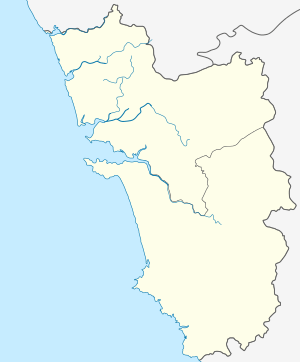Cortalim
Cortalim (pronounced [kuʈʈʰaːɭĩː]) is a village in Mormugão, Goa, India. Its population are mostly Christians and their main occupation is fishing and agriculture. Located on the banks of the Zuari River, it was previously known as Kushasthale.
Cortalim | |
|---|---|
village | |
.jpg) River Zuari near Cortalim | |
 Cortalim Location of Cortalim in Goa  Cortalim Cortalim (India) | |
| Coordinates: 15°23′52″N 73°54′38″E | |
| Country | India |
| State | Goa |
| District | South Goa |
| Sub-district | Mormugao |
| Area | |
| • Total | 8 km2 (3 sq mi) |
| Population | |
| • Total | 15,000 |
| • Density | 1,900/km2 (4,900/sq mi) |
| Time zone | UTC+5:30 (IST) |
| Postcode | 403710 |
| Area code(s) | 0832 |
| Vehicle registration | GA 06 |
The village is well known as the site of an ancient temple dedicated to Shiva. There is also a cross commemorating the arrival of Christianity, together with St Philip and James Church. A new road bridge is being constructed at Cortalim as part of the elevated road scheme that connects South and North Goa.
Location
Cortalim is located roughly midway on the main route connecting Panjim to Margao and Vasco (National Highway 17). It is located 16 kilometres to the south of Panjim, 17 kilometres to the north of Margao and 8 kilometres from Mormugao.
History
The current local name for the village, Kutthalle, is derived from the previous name Kushasthale (place where holy grass is grown for ritual sacrifice), also attributed to Krishna's birthplace, Dwarka. Before the Portuguese conquest of Goa, Cortalim village was the site of the Magueshi temple, dedicated to a form of Shiva. During the demolition of temples as part of the Goa Inquisition, the idol was shifted to its current location in Priol, Ponda. During the Portuguese era, the village was a part of the taluka of Salcete. In 1543, it became the first Goan village where Christianity was officially introduced. On 1 May 1560, the first Holy Mass was conducted here by Fr Pedro Mascarenhas, a Jesuit priest.
Novo Palmar, Thana, Nauta, Consua, 1st Arvalle, 2nd Arvalle, Zomboll, Chovoth, Vollant, Igorje Vaddo, Bondir, Maddant, Panzentar, Chaudi, Sotrant, Gallio, Almabhat, Dumiabhatt and Virabhat are the various wadde (wards) of the village.[1]
Demographics
According to the 2011 Census, Cortalim has a population of 9080 people, with 25% belonging to the Scheduled tribes.[2]
Attractions
- Foodgrain godowns: During Portuguese rule, these godowns on the banks of the Zuari river were used by the Portuguese Board of External Trade (Commercio Junta Externo) to store foodgrains.
- St Philip and St James Church: Built in 1566, it is one of Goa's oldest churches.
- Chapel of Sacred Heart of Jesus: Situated in Manxer, it hosted Salcete's first Mass in 1560.
- Our Lady of Perpetual Succour Primary School: Running out of an ancestral house, this school has completed more than 50 years.
- Mangueshi Temple: Constructed around 10 years ago at Voddant, reminiscing the original temple.
- Colacos' ancestral house: This 180-year-old building now lies in ruins.
- Kolvontachem Tollem: Literally translating to "lake of the temple dancers", this lake was the bathing site for the dancers of the original Magueshi temple and is now in ruins.
- Cruise Point: Set up close to the godowns at Novo Parmar, it is the boarding point for river cruises through the villages of Madkai and Quelossim.[1]
References
- Mendis, Isidore (7 February 2018). "Cortalim: Where all routes meet". The Times Of India - Goa. Retrieved 9 January 2019.
- "2011 Census Data - South Goa". Census of India.
External links
